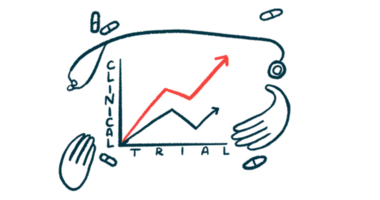AAV-GAD gene therapy eases Parkinson’s symptoms in early study
Life quality improved for most patients, trial data show

Treatment with the experimental gene therapy AAV-GAD led to significant easing of motor symptoms and improved life quality for most people with Parkinson’s disease in an early clinical trial, according to new data announced by the therapy’s developer MeiraGTx.
“We are excited about these impressive clinical data in Parkinson’s disease,” said Alexandria Forbes, PhD, president and CEO of MeiraGTx, said in a company press release.
AAV-GAD is a gene therapy designed to be delivered surgically directly into the subthalamic nucleus, a region of the brain that helps control movement and is affected in Parkinson’s. The therapy uses a modified version of a virus, called adeno-associated virus (AAV), to deliver the GAD gene to brain cells.
The GAD gene provides instructions to make glutamic acid decarboxylase, an enzyme that’s needed to make gamma-aminobutyric acid (GABA), which is a signaling molecule that’s crucial for regulating brain activity. AAV-GAD is designed to boost GABA levels, ultimately aiming to normalize brain signaling and ease symptoms of Parkinson’s. In Parkinson’s, brain activity is disrupted due to abnormally low levels of another signaling molecule called dopamine.
“With the completion of this randomized, double-blinded bridging study, we have also demonstrated with even very small numbers of subjects that AAV-GAD treatment results in significant and clinically meaningful changes in key efficacy endpoints in Parkinson’s disease,” Forbes said.
Targeted delivery
“These data demonstrate the impact of using highly targeted local delivery of gene-based therapy to correct the aberrant circuitry that results from the depletion of dopamine in the brain of idiopathic [of unknown cause] Parkinson’s patients as the disease progresses,” Forbes said.
The Phase 1/2 trial (NCT05603312) enrolled a total of 14 people with idiopathic Parkinson’s, meaning their disease had no clear cause and was not related to known genetic mutations that can in some instances cause Parkinson’s. At the start of the trial, all the patients had a moderate level of motor symptoms while off of symptom-controlling medications, as evidenced by a score of at least 25 points on part three of the Unified Parkinson’s Disease Rating Scale (UPDRS), a standardized assessment.
Five patients were treated with AAV-GAD at a low dose of 70 billion vector genomes, and another five got a high dose of 210 billion vector genomes (vg). The remaining four participants underwent a sham procedure.
Participants were followed for about six months, with the main goal of evaluating safety. No serious safety issues related to AAV-GAD were reported, with Ali Rezai, MD, associate dean of neuroscience at West Virginia University and the study’s principal investigator, noting the safety findings were overall “excellent.”
Data also indicated that AAV-GAD treatment eased motor symptoms in the high-dose group, in which average scores on part three of the UPDRS improved significantly by 18 points while off medication. In the low-dose and sham groups, scores on this measure of motor symptoms did not significantly change over six months of follow-up.
Noting that an improvement of just five to 10 points on the UPDRS part three is considered meaningful for patients, Forbes said this amount of improvement in the high-dose group “underscores the very substantial impact of AAV-GAD treatment in these Parkinson’s patients.”
Patients treated with AAV-GAD also showed significant improvements in the Parkinson’s Disease Questionnaire (PDQ-39) score, a standardized measure of life quality for people with Parkinson’s.
In the high-dose group, all patients showed improvement on the PDQ-39, with average scores rising by 8 points. In the low-dose group, 60% of patients showed PDQ-39 improvements, with average scores improving 6 points. By contrast, only one of the four patients in the sham group showed improvement in PDQ-39 score, and average scores worsened slightly by 0.2 points. According to Forbes, these data “indicate a substantial and clinically meaningful impact of AAV-GAD treatment.”
The AAV-GAD material used in the clinical trial was manufactured by MeiraGTx using the same process that the company hopes to use if the therapy is ultimately approved for commercial use.
“With material made using our proprietary production process at commercial scale, we have demonstrated that AAV-GAD is safe at all doses studied, including a higher dose than previously tested,” Forbes said.
Participants who completed the Phase 1/2 study can enter into an extension study (NCT05894343) in which all will be treated with the gene therapy and monitored for up to five years after treatment. In the meantime, MeiraGTx is working towards a Phase 3 trial to further explore the therapy.
“The significant, substantial, and clinically meaningful changes observed in this small, sham-controlled study provide us with a clear path forward in our clinical development strategy and underpin our discussions with regulators in the US, Europe, and Japan with the goal of initiating a Phase 3 study to support approval of this disease-modifying treatment globally,” Forbes said.







